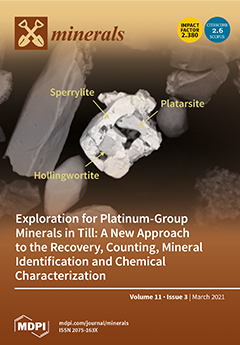In order to reveal the formation mechanism of different garnets and its implications for the fluid evolution in the Laoshankou Fe-Cu-Au deposit in the northern margin of East Junggar (NW China), three types of garnet have been investigated in detail in this study. (1) Type 1 grossular, formed at Ca-silicate stage (stage I, the pre-mineralization stage), was replaced by Type 2 garnet and magnetite, and displays a compositional range of Grs
44–53Adr
44–53, which has relatively lower total REE (rare earth elements) contents (8.14–32.8 ppm) and markedly depleted LREE (light rare earth elements) with distinctive positive Eu anomaly (1.36–9.61). (2) Type 2 Al-rich andradite, formed at the early sub-stage of amphibole-epidote-magnetite stage (stage II, the main magnetite mineralization stage), can be divided into two sub-types, i.e., Type 2a and Type 2b. Type 2a garnets exhibit polysynthetic twinning and relatively narrow compositional variations of Adr
63–66Grs
31–34 with HREE-(heavy rare-earth elements) enrichment and positive Eu anomalies (3.22–3.69). Type 2b garnets own wide compositional variations of Adr
55–77Grs
21–43 with relatively higher REE contents (49.1–124 ppm), markedly depleted LREE and a distinctive positive Eu anomaly (2.11–4.61). (3) Type 3 andradite (Adr
>91) associated with sulfide stage (stage III, the main copper-gold mineralization stage) is different from other types of garnets in Laoshankou, which are characterized by lowest total REE contents (1.66–91.1 ppm), flat HREE patterns, LREE-enrichment and the strongest positive Eu anomalies (3.31–45.48). Incorporation of REE into garnet is largely controlled by external factors, such as fluid chemistry, pH, ƒO
2 and water-rock ratios as well as its crystal chemistry. Type 1 and 2 garnets mainly follow the creation of X
2+ (e.g., Ca
2+) site vacancy, e.g.,
. The REE
3+ substitution mechanism for Type 3 garnet is the Na
+-REE
3+ coupled substitutions, e.g.,
, without the evaluation of the creation of site vacancy. The compositional variations from Type 1 to Type 3 garnet indicate significant differences of fluid compositions and physicochemical conditions, and can be used to trace the fluid–rock interaction and hydrothermal evolution of garnet. Type 1 grossular was formed by magmatic fluid under low water–rock ratios and ƒO
2, and neutral pH environment by diffusion metasomatism in a nearly closed system with the preferential incorporation into the grossular of HREE. As the long fluid pore residence and continuing infiltration metasomatism under nearly closed-system conditions, fluids with high water/rock ratios were characterized by increased ƒO
2, more active incorporation of Fe
3+ and REE, and formed Type 2 Al-rich andradite. In contrast, Type 3 garnet formed by oxidizing magmatic fluid under a mildly acidic environment with highest ƒO
2 and water–rock ratios, and was influenced by externally derived high salinity and Ca-rich fluids in an open system. Thus, the geochemical features of different types and generations of garnets in the Laoshankou deposit can provide important information of fluid evolution, revealing a transition from neutral magmatic fluid to oxidizing magmatic fluid with addition of external non-magmatic Ca-rich fluid from the Ca-silicate stage to the sulfide stage. The above proved the fluid evolution process further indicates that the Laoshankou deposit prefers to be an IOCG-like (iron oxide-copper-gold) deposit rather than a typical skarn deposit.
Full article





